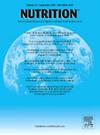Association of loss of visceral adipose tissue after concurrent chemoradiotherapy with poor survival in patients with head and neck squamous cell carcinoma
IF 3.2
3区 医学
Q2 NUTRITION & DIETETICS
引用次数: 0
Abstract
Objectives
Nutritional status is known to be associated with clinical outcomes in head and neck squamous cell carcinoma (HNSCC) patients. The aim of this study was to investigate whether changes in subcutaneous (SAT) and visceral (VAT) adipose tissue mass after concurrent chemoradiotherapy (CCRT) are significantly related to progression-free survival (PFS) and overall survival (OS) in HNSCC patients.
Methods
117 HNSCC patients who underwent definitive CCRT were retrospecitively analyzed. Using unenhanced computed tomography images from pretreatment (PET1) and 3 months post-CCRT (PET2) F-18 fluorodeoxyglucose positron emission tomography (PET)/computed tomography scans, we measured the cross-sectional areas of SAT and VAT. The areas of SAT and VAT were adjusted for height squared to calculate the SAT and VAT indices.
Results
Following CCRT, 92 patients (78.6%) exhibited a decrease in VAT index values. The complete metabolic response (CMR) patient group showed significantly higher values of VAT index at PET2 compared to the non-CMR group (P < 0.05). Multivariate survival analysis found that the VAT index at PET2 and the percent changes in both the SAT index and VAT index were significant predictors for both PFS and OS (P < 0.05). Patients with a low VAT index at PET2 and marked losses of SAT index and VAT index after CCRT had poorer survival outcomes. On subgroup survival analysis, the percent change in VAT index was a significant predictor for PFS and OS in both CMR and non-CMR groups (P < 0.05).
Conclusions
The alteration in VAT mass after CCRT was clinically significant for risk stratification of survival outcomes in HNSCC patients.
头颈部鳞状细胞癌患者同步放化疗后内脏脂肪组织损失与不良生存率的关系
目的:营养状况与头颈部鳞状细胞癌(HNSCC)患者的临床预后相关。本研究的目的是探讨同步放化疗(CCRT)后皮下(SAT)和内脏(VAT)脂肪组织肿块的变化是否与HNSCC患者的无进展生存期(PFS)和总生存期(OS)显著相关。方法回顾性分析117例行明确CCRT的HNSCC患者。使用预处理(PET1)和ccrt (PET2)后3个月的F-18氟脱氧葡萄糖正电子发射断层扫描(PET)/计算机断层扫描的未增强计算机断层图像,我们测量了SAT和VAT的横截面积。SAT和VAT的面积根据高度的平方进行调整,以计算SAT和VAT指数。结果经CCRT治疗后,92例(78.6%)患者VAT指数值下降。完全代谢反应(CMR)患者组在PET2时的VAT指数明显高于非CMR组(P <;0.05)。多变量生存分析发现,PET2时的VAT指数以及SAT指数和VAT指数的百分比变化是PFS和OS的显著预测因子(P <;0.05)。PET2时VAT指数较低,CCRT后SAT指数和VAT指数明显下降的患者生存预后较差。在亚组生存分析中,VAT指数变化百分比是CMR组和非CMR组PFS和OS的重要预测因子(P <;0.05)。结论CCRT后增值率的改变对HNSCC患者生存结果的危险分层具有临床意义。
本文章由计算机程序翻译,如有差异,请以英文原文为准。
求助全文
约1分钟内获得全文
求助全文
来源期刊

Nutrition
医学-营养学
CiteScore
7.80
自引率
2.30%
发文量
300
审稿时长
60 days
期刊介绍:
Nutrition has an open access mirror journal Nutrition: X, sharing the same aims and scope, editorial team, submission system and rigorous peer review.
Founded by Michael M. Meguid in the early 1980''s, Nutrition presents advances in nutrition research and science, informs its readers on new and advancing technologies and data in clinical nutrition practice, encourages the application of outcomes research and meta-analyses to problems in patient-related nutrition; and seeks to help clarify and set the research, policy and practice agenda for nutrition science to enhance human well-being in the years ahead.
 求助内容:
求助内容: 应助结果提醒方式:
应助结果提醒方式:


